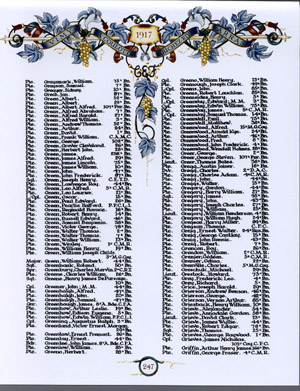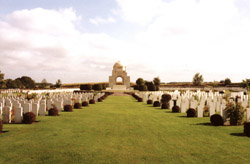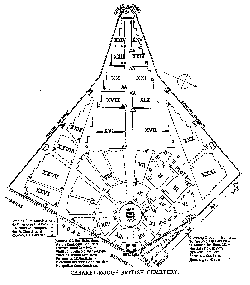

In memory of
Private
ALEXANDER "SANDY" GRIEVE
August 9, 1882 - March 1, 1917
Military Service
Service Number: 687337Age: 35
Force: Army
Unit:Canadian Infantry (Central Ontario Regiment)Division:54th Batallion (the Kooteneys), 4th Division
Commemorated on Page 247 of the First World War Book of Remembrance.
Medium sized pop-up image
600 X 782, 200 dpi, 175 k
Military Attestation papers:
When a recruit signed up for the Canadian Expeditionary Force in WW I he filled in an attestation paper that indicated his willingness to serve in the military and provided such information as date of birth, next of kin, height, weight, complexion, occupation, etc. As such these papers are of genealogical importance. The links below are to a scanned copy of the attestion papers of Alexander "Sandy" Grieve completed on 19 January, 1916 (28th Jan scratched out), in Kamloops, British Columbia when he was inducted in the 172nd Batallion.
Medium sized pop up image
of military attestation paper (front)
700 X 1129, 72 dpi, 40 kFull sized pop up image
of military attestation paper (front)
1012 X 1632, 72 dpi, 73 kMedium sized pop up image
of military attestation paper (back)
700 X 1129, 72 dpi, 31 kFull sized pop up image
of military attestation paper (back)
1011 X 1632, 72 dpi, 57 kDate of Enlistment:
January 19 (28th Jan scratched out) 1916, Kamloops, British Columbia, CanadaAdditional Information:
Private Alexander "Sandy" Grieve was the son of George Alexander Smith Grieve and Harriett "Hattie" Pass, The family moved to BC in 1890 (McEwen, 2004). Born 9 Aug 1881, Harvey, and died 1 Mar 1917, WWI, France."Sandy was a switchman for the CPR living in Vancouver with his parents on West 7th Avenue in 1907 and 1908. In 1911, he was a yard foreman living on Smithe Street. Ref.--City Directories for Vancouver.
"From Sandy's service record, we learn that Sandy was living with his father in Penticton, BC, when he enlisted in Kamloops in 1916 and his trade was a brakeman. He enlisted for the Canadian Overseas Expeditionary Force on 19 Jan (28th Jan scratched out) 1916. He was assigned to the 172nd Battn with the rank of Private. He embarked from Canada 25 Oct 1916 and arrived in England on the SS Maurentania, 31 Oct 1916. On 5 Dec 1916 he proceeded to Bramshott, France, with the 54th Battn arriving two days later. On 15 Dec 1916 he left Bramshott for action in the field. He was killed in action 1 Mar 1917." (McEwen, 2004, p. 85).McEwen, W. 2004. The Grieve Saga: The Family of William Grieve & Eleanor Turnbull and their Descendants (1794-2004) from Harvey, NB and the Comox Valley, BC" (ISBN 0-9735932-0-2),
Cemetery:
Cabaret-Rouge British Cemetery, Souchez, Pas de Calais, FranceGrave Reference:
XIII. D. 9Location:
Souchez is a village in the Department of the Pas-De-Calais, 3.5 kilometres north of Arras on the main road to Bethune. It lies in the valley of the Souchez river, between the Lorette Bridge to the west and Vimy Ridge to the east. The Cabaret-Rouge British Cemetery is about 1.5 kilometres south of the village on the west side of the D937 Arras-Bethune Road.On 26 September 1915, Souchez was taken from the Germans by French troops, who handed the sector over to Commonwealth forces the following March. The village was completely destroyed. The "Cabaret Rouge" was a house on the main road about 1 kilometre south of the village, at a place called Le Corroy, near the cemetery. On the east side, opposite the cemetery, were dugouts used as battalion headquarters in 1916. The communication trenches ended here, including a very long one named from the Cabaret. The cemetery was begun by Commonwealth troops in March 1916, used until August 1917 (largely by the 47th (London) Division and the Canadian Corps) and - at intervals - until September 1918; these original burials are in Plots I to V inclusive. It was greatly enlarged after the Armistice when more than 7,000 graves were brought in from the battlefields of Arras and from 103 other burial grounds in the Nord and the Pas-de-Calais. The cemetery now contains 7,655 Commonwealth burials of the First World War, more than half of them unidentified. There is also one Second World War burial. On 25 May 2000, the remains of an unidentified Canadian soldier were entrusted to Canada at a ceremony held at the Vimy Memorial, France. The remains had been exhumed by staff of the Commonwealth War Graves Commission from Cabaret-Rouge British Cemetery, Souchez, Plot 8, Row E, Grave 7. The remains were laid to rest within the Tomb of the Unknown Soldier, in a sarcophagus placed at the foot of the National War Memorial, Confederation Square, Ottawa, Canada.
Number of identified casualties:
3187
Cabaret-Rouge British Cemetery
Medium sized pop-up image
700 X 459, 72 dpi, 119 kLarge sized pop-up image
1741 X 1141, 300 dpi, 768 kCabaret-Rouge British Cemetery Plan
Medium sized pop-up image of Map
500 X 570, 72 dpi, 13 kLarge sized pop-up image of Map
1920 X 2188, 72 dpi, 89 kDisastrous Trench Raid Vimy Ridge (1 Mar 1917)
During the early months of 1917 the Canadian Corp was training for it's famous assault on Vimy Ridge that would take place on April 9, 1917. In preparation for the battle to come the Canadians continually probed the German defenses via trench raids to map the terrain, assess enemy strength and to obtain intelligence. The Canadian Corps in fact "owned" No-Man's Land in the night hours, patrolling right into the German trenches at will. Some raids were on a very large scale though, and not always successful. Such was the case of the Division-scale raid launched in the early hours of 1 Mar 1917 when 1700 men of the Canadian 4th Division launched a phosgene and chlorine gas attack on Vimy Ridge in support of a major trench raid. The 54th Batallion contributed 15 officers and 390 men of other ranks, including Private Sandy Grieve. As outlined in the transcript of the 54th Battalion War Diary entries below the attack was a disaster. The gas attack was ineffective against the German defenders, supporting artillery fire fell short of the German lines and the soldiers foundered on uncut wire emplacements. The soldiers were mowed down by heavy machine gun fire and heavy rifle fire before they could make any headway. Many who dived into shell craters to escape the gun fire were often killed by their own phosgene gas as it tended to accumulate in any hollow. By the time the attack ended 13 of the 15 officers were dead or wounded including the Batallions experienced and decorated commander Lieut. Col. A.H.G. Kemball, CB, D.S.O. Amongst Other Ranks there were 77 dead, 126 wounded and 10 missing. Private Sandy Grieve was amongst the dead. On the next day, 2 Mar 1917, a short informal truce was arranged with the Germans to recover dead and wounded. Soldiers from both sides helped recover the dead and shared cigarettes and stories before the higher ups got wind of the cease fire and put a stop to it by noon. Never-the- less not one shot was fired in that sector for the rest of the day. As a footnote the 4th Division was so weakened by the losses taken by the 54th Btn and other units that it had not fully recovered by the time of major attack on Vimy Ridge on 9 Apr 1917. This resulted in the 4th Division having difficulty taking its objectives.
A very comprehensive discussion of the background planning, implementation and outcome of the 1 March trench raid is found in Pierre Berton's excellent book "Vimy" p. 126-135, which describes the significance of the Battle of Vimy Ridge in Canada's march to full nationhood.
Berton, P. 1986. Vimy, McClelland and Stewart, Toronto. ISBN 0-7710-1339-6, 336 p.
Extract From War Diary 54th Batallion, 4th Division, Canadian Expeditionary Force
Pop up jpg scan of original 54th
War Diary 1 Aug, 1917
1100 X 688, 72 dpi, 199 k
Pop up jpg scan of original 54th
War Diary 1 cont., 2 Aug, 1917
1100 X 671, 72 dpi, 191 kPop up jpg scan of original 54th
War Diary 2 cont 3, 4 Aug, 1917
1100 X 669, 72 dpi, 190 k
Vimy Ridge 1st March 1917
The Battalion took part in a Divisional Gas Attack. Gas being discharged on the 11th and 12th Canadian Infantry Brigade's fronts. Object - to destroy enemy works and gain information. The 2nd Canadian Division on our right (22nd Batn.) cooperated with a smoke barrage. The 75th Cdn Inf Bn on our left. 15 officers and 390 OR took part. Programme as follows.
First Gas discharge, 3 am. Second Gas discharge 4:45 am, Advance from Assembly Trench to No-Man's Land, 5:15 am; Assault 5:40 am. Owing to the unfavourable wind second discharge of gas did not take place on the Brigade frontage. Enemy retaliated as first wave was dicharged with heavy machine gun fire and gas shells, quieting down about 3:45 am. Advance to No-Man's Land carried out without serious opposition but heavy rifle and machine gun fire opened all along the front as the Battalion deployed in No Mans Land. First discharge of gas apparently had no effect on the enemy. In the face of heavy rifle and machine gun fire assault was carried out at 5:40 am, but owing to strong wire entanglements before their front line no headway could be made and owing to the retirement of the Battalion on our left we conformed shortly after.
Artillery barrage was not sufficiently consecrated and caused no slack during of the enemy's fire. Was registered correcly on our right but very short on our left & centre, where the chief casualties occurred. - Casualties - Officers. 6 killed 7 wounded. Other Ranks 77 killed, 126 wounded, 10 missing.
At night efforts were made to bring in wounded from No-Man's Land but owing to the alertness of the enemy had to be abandoned. -
Casualties in officers: Killed:- Lieut. Col. A.H.G. KEMBALL, CB, D.S.O., Major F.T. LUCAS, Capt. N.L. TOOKER, Lieut.s A.B. JACKSON, W.A. REDDOCK, J.L. EVANS. - Wounded Capt. R.B.M CAMERON, Lieuts. R.J. HOSIE, M.C., H.F.G. LETSON, W.L. MAWHINNEY, A.F. GRAVES, G.W. FOOTE, H.E. JOHNSON
Vimy Ridge 2nd
Weather fine. Battalion relieved by 87th Canadian Inf. Bn. & proceeded to MUSIC HALL LINE. "B", "C" and "D" Comps. in MUSIC HALL. "A" Comp moved up in support of the 87th Battalion. At night parties of Scouts and Volunteers brought in several bodies from No - Man's Land. - Lieut W.L. Mawhinney died of wounds.
Music Hall Line 3rd
Weather fine - Armistice arranged with enemy whereby it was agreed both sides should clear No Man's Land of dead bodies. 43 bodies of our own men recovered, amongst them were Lieut Col. KEMBALL, Major LUCHS and Capt. TOOKER. Armistice terminated at 12 noon. "D" Comp. moved into the BATOLLE LINE north of WORTLEY.
Music Hall Line 4th
Weather fine. Pre-arranged armistice cancelled. Burying party under Lieut. J.T. SMEETON buried several bodies in No-Man's Land under cover of darkness. Funeral of Lieut. Col. A.H.G. KEMBALL, CB, D.S.O., Major F.T. LUCAS and Capt. N.L. TOOKER held at VILLERS AU BOIS at 2 pm and attended by Maj. General D. WATSON, C.B., Col. E. IRONSIDES, D.S.O., Lt. Col. E. de B. PANET and Lt. Col. R.D. Davies and all available officers of the Battalion. Firing party supplied from 5th Btn.
Source:
Veterans Affairs Canada
National Archives of Canada


